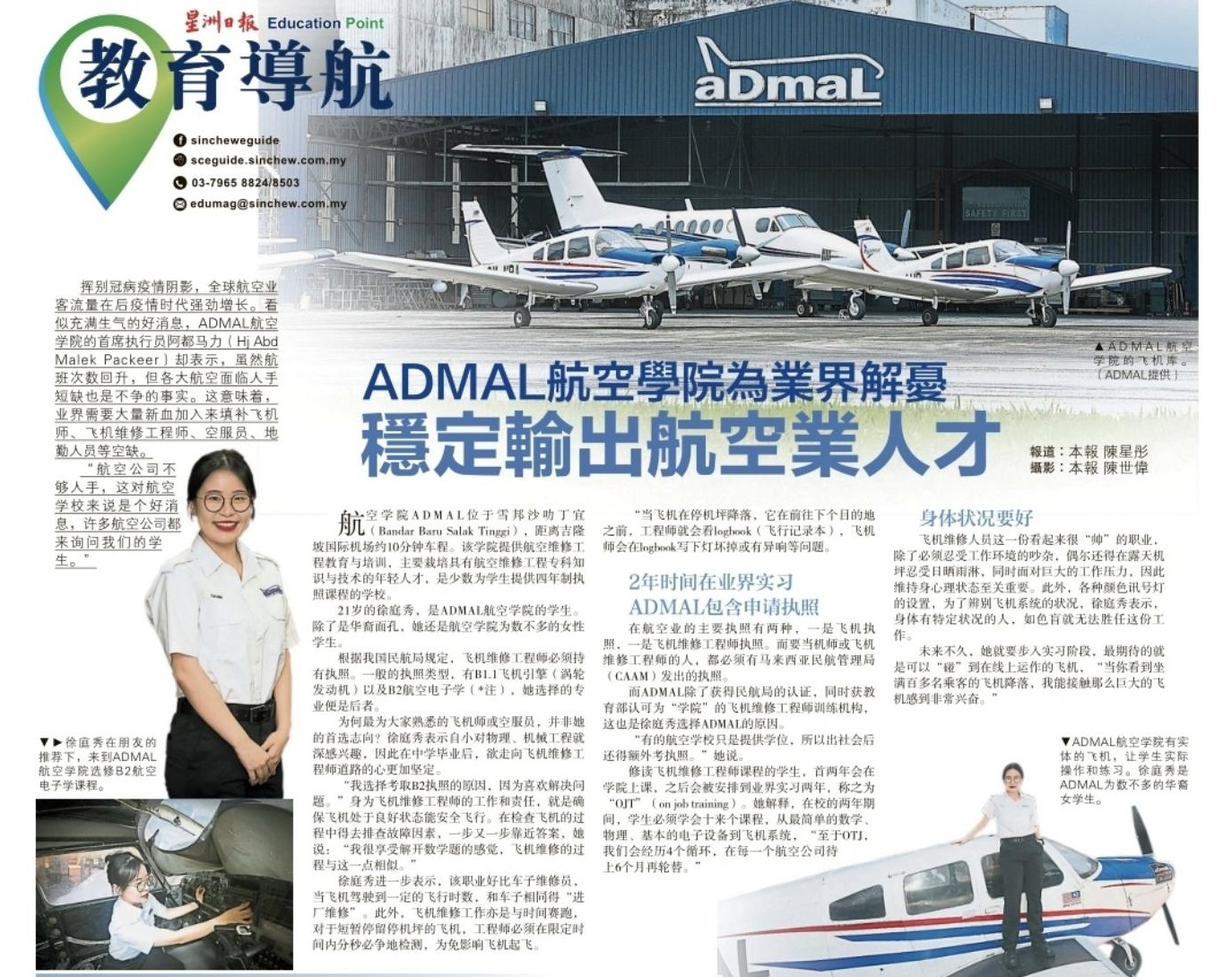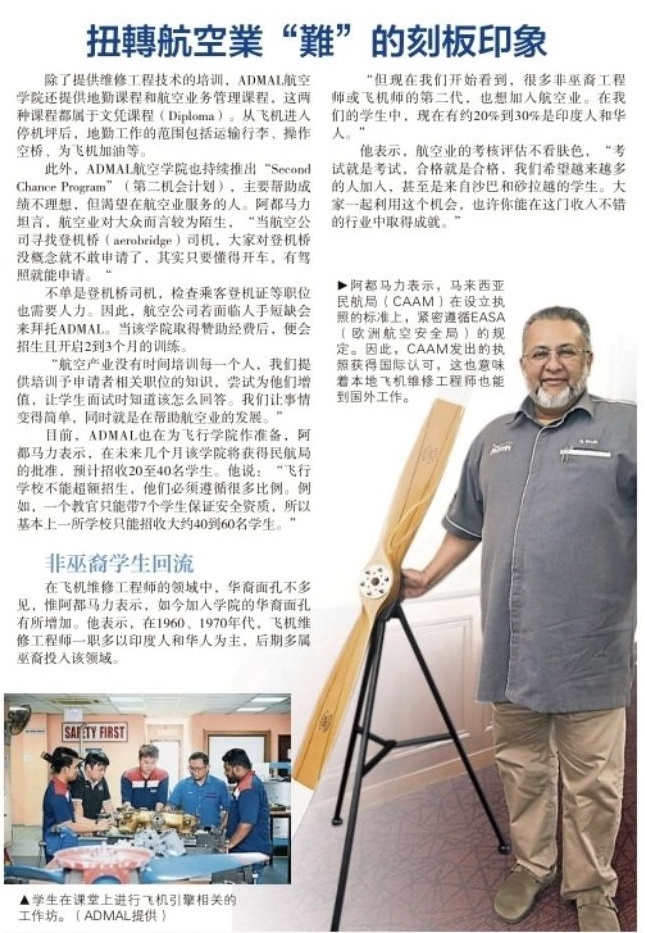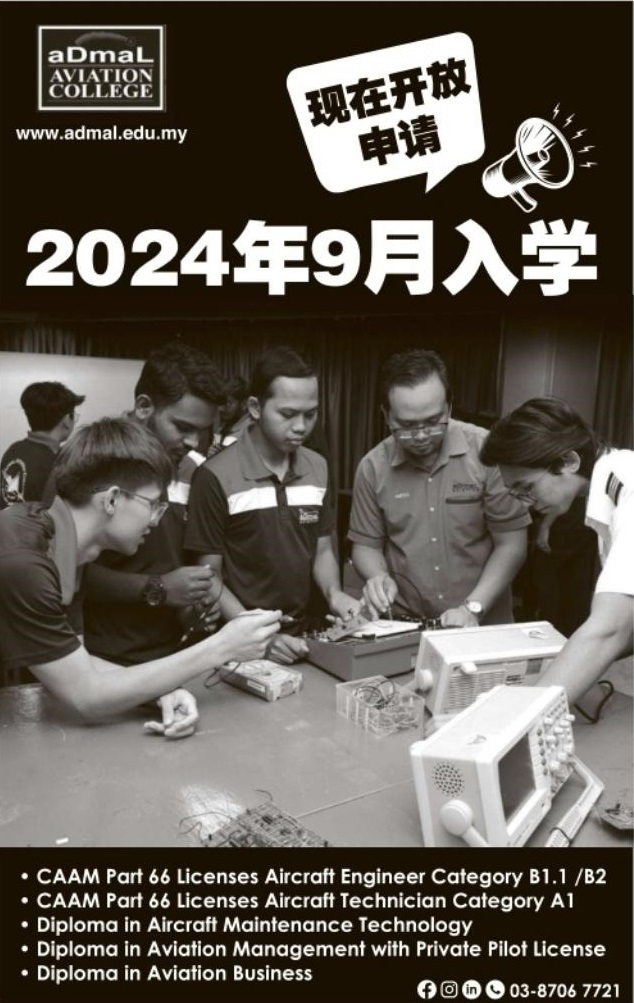
As the world moves past the shadow of the COVID-19 pandemic, the global aviation industry has experienced a strong resurgence in passenger traffic. While this seems like good news, Hj Abd Malek Packeer, the CEO of ADMAL Aviation College, notes that despite the increase in flight frequency, a significant challenge persists—airlines are facing a manpower shortage. However, this also means a high demand for new talent to fill roles such as pilots, aircraft maintenance engineers, flight attendants, and ground staff.
“Airlines are struggling with a manpower shortage, which is good news for aviation schools. Many airlines are inquiring about our students,” says Abd Malek.
ADMAL Aviation College, located in Bandar Baru Salak Tinggi, Sepang, is approximately a 10-minute drive from Kuala Lumpur International Airport. The college offers education and training in aircraft maintenance engineering, mainly focusing on cultivating young talents with specialized knowledge and skills in this field. It is one of the few institutions offering a four-year licensing course for students.
Xu Tingxiu, a 21-year-old student at ADMAL Aviation College, is one of the few female students in the college, and one of the even fewer who are of Chinese descent.
According to the Malaysian Civil Aviation Authority’s regulations, aircraft maintenance engineers must be licensed. The common types of licenses are B1.1 (aircraft engines, particularly turbine engines) and B2 (avionics), and Xu has chosen to specialize in the latter.
Why didn’t she choose the more well-known professions of pilot or flight attendant? Xu explains that she has been interested in physics and mechanical engineering since childhood. Therefore, after graduating from high school, she became even more determined to pursue a career as an aircraft maintenance engineer.
“I chose to pursue a B2 license because I enjoy problem-solving,” she says. The work and responsibility of an aircraft maintenance engineer are to ensure that the aircraft is in good condition and safe to fly. During the inspection of the aircraft, engineers must troubleshoot any issues, gradually working toward a solution. Xu compares the process to solving math problems, a challenge she relishes.
Xu further explains that the profession is similar to being a car mechanic. When an aircraft reaches a certain number of flight hours, like cars, it needs to undergo maintenance. Additionally, aircraft maintenance work is a race against time. For aircraft with brief layovers, engineers must quickly inspect them within a limited timeframe to avoid delays in departure.
“When an aircraft lands on the tarmac before it heads to the next destination, engineers will check the logbook. Pilots record issues such as malfunctioning lights or strange noises in the logbook.”
Two Years of Industry Internship
ADMAL offers licensing applications as part of its course. To become a pilot or aircraft maintenance engineer, one must have a license issued by the Civil Aviation Authority of Malaysia (CAAM). ADMAL is not only certified by CAAM but is also recognized as a college by the Ministry of Education, making it a specialized training institution for aircraft maintenance engineers. This is why Xu chose ADMAL.
“Some aviation schools only offer degrees, so after graduating, you still have to obtain the license separately,” she explains.
Students enrolled in the aircraft maintenance engineering course at ADMAL spend the first two years attending classes at the college. They are then assigned to a two-year industry internship called “OJT” (on-job training). Xu explains that during the first two years at the college, students must master about ten courses, ranging from basic subjects like math, physics, and electronics to aviation systems. “As for OJT, we undergo four rotations, spending six months at each airline before moving on to the next.”
Physical Fitness Is Key
While the job of an aircraft maintenance engineer may seem “cool,” it also requires enduring noisy work environments, sometimes working in open-air tarmacs under harsh weather conditions and facing immense pressure. Therefore, maintaining good physical and mental health is crucial. Additionally, the different colored signal lights used in the profession to indicate the status of aircraft systems mean that those with specific physical conditions, such as color blindness, may not be suited for this career.
Soon, Xu will begin her internship, and she is most excited about working on operational aircraft. “When you see an aircraft carrying hundreds of passengers land, I feel very excited to be able to work on such a massive machine.”

Breaking the Stereotype of the "Difficult" Aviation Industry
In addition to offering maintenance engineering training, ADMAL Aviation College also provides diploma courses in ground operations and aviation business management. Ground operations include handling baggage, operating the aerobridge, and refueling aircraft.
Furthermore, ADMAL Aviation College continues to offer its “Second Chance Program,” which aims to help individuals who may not have excelled academically but are eager to work in the aviation industry. Abd Malek acknowledges that the aviation industry is unfamiliar to many. “When airlines are looking for aerobridge drivers, people hesitate to apply because they don’t understand what it entails. But actually, as long as you know how to drive and have a license, you can apply.”
It’s not just aerobridge drivers; positions like checking boarding passes also require manpower. Therefore, when airlines face a manpower shortage, they often turn to ADMAL for help. Once the college secures sponsorship funds, it recruits students and offers two to three months of training.
“The aviation industry doesn’t have time to train every individual, so we provide training to equip applicants with the necessary knowledge for the job, helping them add value and know how to respond during interviews. By simplifying the process, we’re also contributing to the growth of the aviation industry.”
Non-Malay Students Are Returning
In the field of aircraft maintenance engineering, it’s rare to see students of Chinese descent. However, Abd Malek notes that the number of Chinese students at the college has been increasing. He mentions that in the 1960s and 1970s, aircraft maintenance engineers were predominantly Indian and Chinese, but later, more Malays entered the field.
“But now we’re starting to see the second generation of non-Malay engineers or pilots also wanting to join the aviation industry. Among our students, about 20% to 30% are Indians or Chinese.”
He emphasizes that the aviation industry’s assessments and evaluations are not based on ethnicity. “Exams are exams, and passing is passing. We hope more people will join, even students from Sabah and Sarawak. Take advantage of this opportunity, and perhaps you can achieve success in this well-paying industry.”








